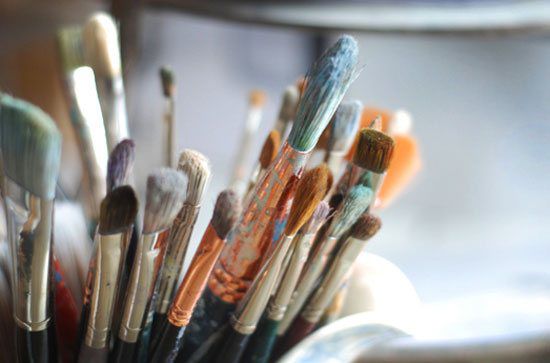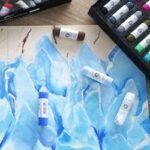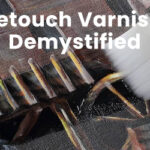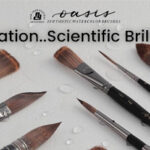Winsor & Newton’s Complete Guide to Brush Selection and Care

CHOOSE THE BRUSH THAT’S RIGHT FOR YOU
The Complete Guide to Brush Selection and Care
A HERITAGE OF SKILL
Every artist knows that painting takes years of dedication, patience, and skill. Just like making the world’s finest brushes. For thousands of years, the basic elements of the brush have remained the same. But making a brush today worthy of that heritage requires generations of skill, an understanding of which hairs provide the greatest expressive control, an uncompromising eye in selecting the finest raw materials, and the experience that shows that – while some things can be better achieved with machines and technology – there are some that can still be done only with the human hand and eye. Like making brushes that have no peer.
THE STANDARDS OF HISTORY
Winsor & Newton has been supplying fine artists’ brushes for more than 160 years. In that time, the company has acquired the reputation for making the very best from the very finest materials available.
In 1946, the growing company needed a facility exclusively for brush making. The English port town of Lowestoft was ideal due to the availability of an historic factory and room for growth. Furthermore, Lowestoft had a long history as a fishing village, offering a work force with generations of skill in the mending of fishing nets. Workers in Lowestoft were uniquely able to meet the exacting demands of hand tying hairs for artists’ brushes.
Yearly, skilled brush makers at the Lowestoft facility now produce brushes requiring over 200 miles of ferrules and over 1000 miles of wooden handles if they were placed end to end. And we still employ brush makers that take, quite literally, years to perfect the skills to produce the only brushes still hand taper dressed in our own factory in England and tied entirely by hand. Because that’s still the only way to
make a brush that measures up to your standards and ours.
CHOOSING THE RIGHT BRUSH
The right brush serves as a fluid extension of the hand, wrist, and mind. The wrong brush for the job – or a brush of poor quality – becomes a hindrance or an obstacle.
HEAD (OR ‘TUFT’) of Art Brush

 • Evenly and crisply shaped (not split or splayed)
• Evenly and crisply shaped (not split or splayed)
• Natural hairs should be evenly tapered (not blunt or cut)
• Hair or filaments should be tightly bound, with no gap
at the ferrule and no shedding
FERRULE of the Brush

 • Seamless (to prevent internal seepage)
• Seamless (to prevent internal seepage)
• Tightly secured to the handle with deep double crimps
• Smooth finish and edges
• Rustproof
HANDLE of brush

 • Straight and symmetrical
• Straight and symmetrical
• No chips or cracks or raw wood
• Well-balanced with comfortable weight and grip
• Clear imprint
A NOTE ON BRUSH SIZES
Numerical sizes vary among manufacturers. For example, other brush makers may label a brush as a size 10 that compares in size to a Winsor & Newton size 8 or 6. The only way to evaluate relative sizes and value is to compare the actual size of brush to brush. We’re confident that you’ll find the relative sizes of Winsor & Newton brushes to represent excellent value for money.
• Point – Does it come to a crisp point and hold that point during use?
• Snap and spring – Does the brush spring crisply back into shape? The right degree
of spring allows superior control over the brush on the painting surface.
• Flow control – Does colour flow evenly and consistently from the point? Is there
enough capacity within the ‘belly’ of the brush to lay down flowing, gestural strokes of
colour?
The hair that best meets these needs is taken from carefully selected kolinsky sable tails. When properly made, a kolinsky brush offers a rapier-like point, perfectly balanced spring, and extraordinary capacity and flow control. Since 1866, the hand-made Winsor & Newton Series 7 has been the standard-bearer in all of these qualities. Other hairs that offer varying degrees of performance include:
Natural Hair Watercolor Brushes
• Good performance: second-grade sable, squirrel (for wash brushes), and synthetic/natural hair blends (Winsor & Newton Sceptre Gold II) or synthetic alone (Winsor & Newton Cotman).
• Moderate performance: ox (sabeline), goat, and camel (not true camel hair, but a mixture of soft hair).
When comparing brushes, note that some manufacturers will declare a brush as “kolinsky sable,” when the hair has been taken from a part of the animal that produces hair poorly suited for brush making. Or brushes labeled as “sable” may have been taken from weasel or another animal with hair of lesser quality. Be assured that the Winsor & Newton Series 7 brush is hand taper dressed by our own factory in England exclusively from true kolinsky sable tail hair of the finest selected quality.
• Firmness of bristle – Is the bristle capable of moving heavy-bodied colour over the surface with authority?
• Tip control – Does the bristle or hair allow subtlety and nuance in blending? Fine control when creating detail?
For heavy-bodied colour, the ideal bristle is from hog or boar. Properly dressed, the finest quality hog brushes—like Winsor & Newton Rathbone— offer superior firmness and flagged ends for nuanced control and blending. In addition, fine hog bristle can be naturally ‘interlocked’ during manufacturing to create a tight, well formed brush head that guarantees superior control. As colour is ‘let down’ for finer blending or glazing work, the ideal hair is softer and more supple, such as badger or a synthetic (Winsor & Newton Monarch brush).
• Firmness of bristle – Is the bristle capable of moving heavy-bodied colour over the surface with authority?
• Tip control – Does the bristle or hair allow for subtlety and nuance in blending?
• Undamaged by water or acrylic resins?
Over the past decades, synthetics have proven superior in making brushes for acrylic colours (Winsor & Newton Galeria acrylic brushes). Synthetic filaments can be produced with a range of ‘springiness.’ With the proper manufacturing techniques, they offer good flow control, and a well-defined tip or edge for detail and blending work. And they are resistant to damage from acrylic resin and won’t soften in water (as will natural bristle brushes).
THE CARE OF BRUSHES
Fine brushes will offer many years of service – if the following very simple points are followed:
• Always clean your brushes immediately after use
• Do not leave brushes soaking in solvents or water for an extended period of time

• Never leave brushes resting on their heads or tufts
• Shape the head after cleaning
• Never point a brush in your mouth
ADDITIONAL CARE
Sable
• Avoid storage in direct sunlight
• For prolonged storage, store sable brushes in an air tight box
• Mothballs may be used to deter moths
• Sable brushes used for water colour should not be used with other media
Hog
• To restore a damaged or blunt brush head, dip bristles in boiling water, blot on towel, and shape head
• Brushes used with oil will acquire and keep a slight residue, and should not be used with other media
Acrylic
• If filaments clump or separate, completely clean all paint from the heel or ferrule end of the brush head using a full-strength brush cleaner such as Winsor & Newton Brush Cleaner & Restorer
6 CLEANING INSTRUCTION TIPS FOR ART BRUSHES
1. For brushes used with oils, dip brush in household vegetable oil and wipe free of excess colour and oil with a soft, lint-free rag.
2. Brushes used with acrylic or water colour should be wiped clean on a lint-free rag and then rinsed under running water.
3. Clean brushes gently with mild soap or Winsor & Newton Brush Cleaner. Cold water for sable, luke warm for hog and synthetic. Swirl brush against a smooth, shallow surface (never in the palm of your hand, especially with brushes that may still contain oil or solvent).
4. Wash and rinse until water runs clear from the brush. Take particular care to ensure that the heel of the brush is clean. Some pigments may stain the brush slightly, but this will not affect the performance or life of the hair.
5. Gently re-shape the head and allow to dry.
6. For brushes caked with dried acrylic or oil colour, use Winsor & Newton Brush Cleaner & Restorer.





